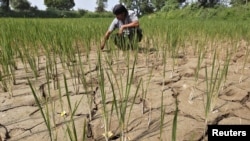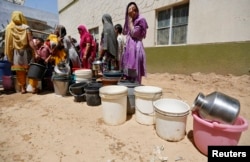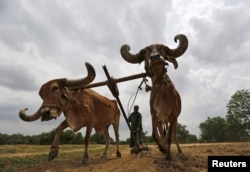At a time when large parts of India are reeling under severe drinking water shortages and a farming crisis triggered by two straight years of drought, forecasts of plentiful monsoon rains this year have raised hopes that distress in rural areas will ease.
The announcement from the Indian Meteorological Department that rains will be 106 per cent above average came as authorities dispatched a train carrying half a million liters of water to one of the country’s most parched districts, Latur in western Maharashtra state.
Latur water shortages
Latur has been in the national spotlight in recent days as it reels under acute water scarcities as the hot summer sets in. It is not alone — 11 states are coping with the same problem.
A resident and farmer in Latur, Arun Kulkarni, says taps have been dry since a month ago when a dam close by ran out of water.
According to Kulkarni, while those with vehicles go and fetch water from areas 10 or 15 kilometers away and those who have money buy it, the situation is dire for the poor, who spend hours scrambling to get hold of a few liters of water.
“Poor families make do with just one container of water, in just one container, five or six people manage” he said. Even though temperatures are rising, residents say bathing is a rare luxury.
So severe is the water crisis in Latur that policemen guard tankers that ferry water into parched villages and authorities have imposed restrictions on those gathering around tankers to five to prevent squabbles.
The severe water shortages across parts of Maharashtra prompted the Mumbai High Court on Wednesday to order all matches of a popular cricket tournament to be held outside the state after April 30th because this will save millions of liters of water used to maintain cricket pitches.
According to the Central Water Commission, water availability in India’s 91 major reservoirs was 25 percent of total capacity at the end of March — the lowest in a decade.
Farm sector
Large parts of India are not just grappling with a drinking water crisis — the poor rains have also ravaged crops and hurt farm output. As more than half of its farmlands are rain fed, the country is still heavily dependent on the four-month monsoon period from June to September.
Many farm activists in Maharashtra are calling on the government to frame policies to halt the production of water-intensive crops in Maharashtra. A member of parliament, Raju Shetti, who also heads a farmers group in the state explained that “farmers grow crops like sugar cane and bananas because they are more profitable. The government must give incentives to farmers to switch to crops like pulses and oilseeds which need less water.”
India’s economy is growing well despite the slowdown in the farm sector because agriculture contributes only 15 percent to the country’s gross domestic product. However, farm-based livelihoods support more than half the population, leading to widespread rural distress when rains fail — a problem the government acknowledged recently when it vowed to spend billions of dollars to double farm incomes in five years.
That is why forecasts of above average rains this year could be critical for India. Authorities hope not only will the rains fill up rivers, dams, aquifers and wells, they will also help farmers harvest a good crop and boost rural earnings.
Shetti said the forecast of ample monsoon is goods news, but points out that in people drought-hit areas still have an agonizing two months to wait till the rains arrive.


